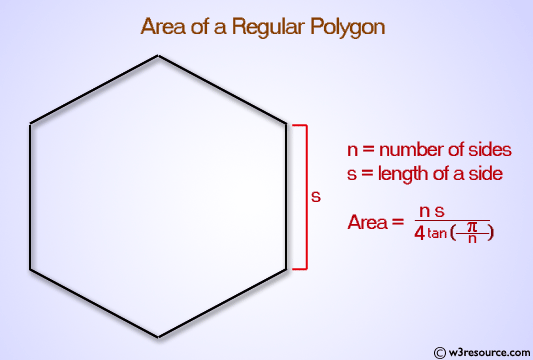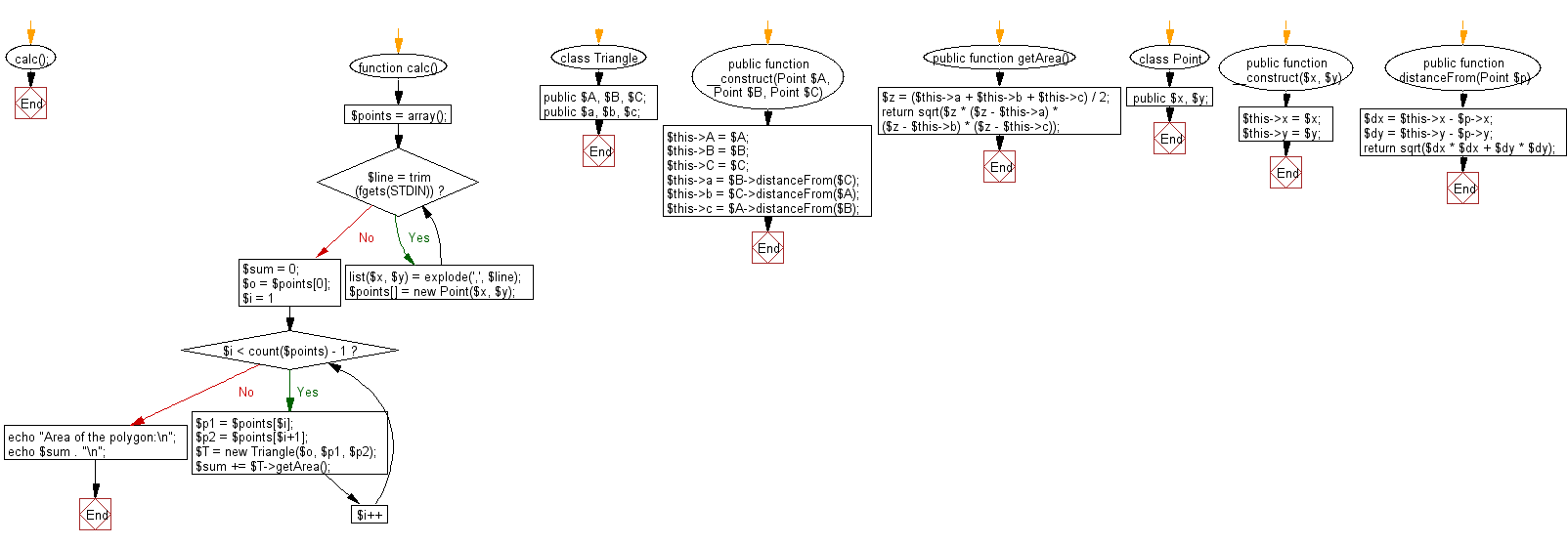PHP Exercises: Compute the area of the polygon
PHP: Exercise-73 with Solution
A convex polygon is a simple polygon in which no line segment between two points on the boundary ever goes outside the polygon. Equivalently, it is a simple polygon whose interior is a convex set. In a convex polygon, all interior angles are less than or equal to 180 degrees, while in a strictly convex polygon all interior angles are strictly less than 180 degrees.
Write a PHP program that compute the area of the polygon . The vertices have the names vertex 1, vertex 2, vertex 3, ... vertex n according to the order of edge connections.
However, n is 3 or more and 20 or less. You can also use the following formula to calculate the area S from the lengths a, b, and c of the triangle's three sides.
Input: Multiple character strings are given. One string is given per line

Pictorial Presentation:

Input:
Input is given in the following format.
x1 , y1
x2 , y2
:
xn , yn
xi , yi are real numbers representing the x and y coordinates of vertex i , respectively.
Sample Solution: -
PHP Code:
<?php
calc();
function calc() {
$points = array();
while ($line = trim(fgets(STDIN))) {
list($x, $y) = explode(',', $line);
$points[] = new Point($x, $y);
}
$sum = 0;
$o = $points[0];
for ($i = 1; $i < count($points) - 1; $i++) {
$p1 = $points[$i];
$p2 = $points[$i+1];
$T = new Triangle($o, $p1, $p2);
$sum += $T->getArea();
}
echo "Area of the polygon:\n";
echo $sum . "\n";
}
class Triangle {
public $A, $B, $C;
public $a, $b, $c;
public function __construct(Point $A, Point $B, Point $C) {
$this->A = $A;
$this->B = $B;
$this->C = $C;
$this->a = $B->distanceFrom($C);
$this->b = $C->distanceFrom($A);
$this->c = $A->distanceFrom($B);
}
public function getArea() {
$z = ($this->a + $this->b + $this->c) / 2;
return sqrt($z * ($z - $this->a) * ($z - $this->b) * ($z - $this->c));
}
}
class Point {
public $x, $y;
public function __construct($x, $y) {
$this->x = $x;
$this->y = $y;
}
public function distanceFrom(Point $p) {
$dx = $this->x - $p->x;
$dy = $this->y - $p->y;
return sqrt($dx * $dx + $dy * $dy);
}
}
?>
Sample Input:
1.0, 0.0
0.0, 0.0
1.0, 1.0
2.0, 0.0
-1.0, 1.0
Sample Output:
Area of the polygon: 1.5
Flowchart:

PHP Code Editor:
Have another way to solve this solution? Contribute your code (and comments) through Disqus.
Previous: Write a PHP program to restore the original string by entering the compressed string with this rule.
Next: Write a PHP program to cut out words of 3 to 6 characters length from a given sentence not more than 1024 characters.
What is the difficulty level of this exercise?
Test your Programming skills with w3resource's quiz.
PHP: Tips of the Day
How to Sort Multi-dimensional Array by Value?
Try a usort, If you are still on PHP 5.2 or earlier, you'll have to define a sorting function first:
Example:
function sortByOrder($a, $b) {
return $a['order'] - $b['order'];
}
usort($myArray, 'sortByOrder');
Starting in PHP 5.3, you can use an anonymous function:
usort($myArray, function($a, $b) {
return $a['order'] - $b['order'];
});
And finally with PHP 7 you can use the spaceship operator:
usort($myArray, function($a, $b) {
return $a['order'] <=> $b['order'];
});
To extend this to multi-dimensional sorting, reference the second/third sorting elements if the first is zero - best explained below. You can also use this for sorting on sub-elements.
usort($myArray, function($a, $b) {
$retval = $a['order'] <=> $b['order'];
if ($retval == 0) {
$retval = $a['suborder'] <=> $b['suborder'];
if ($retval == 0) {
$retval = $a['details']['subsuborder'] <=> $b['details']['subsuborder'];
}
}
return $retval;
});
If you need to retain key associations, use uasort() - see comparison of array sorting functions in the manual
Ref : https://bit.ly/3i77vCC
- New Content published on w3resource:
- HTML-CSS Practical: Exercises, Practice, Solution
- Java Regular Expression: Exercises, Practice, Solution
- Scala Programming Exercises, Practice, Solution
- Python Itertools exercises
- Python Numpy exercises
- Python GeoPy Package exercises
- Python Pandas exercises
- Python nltk exercises
- Python BeautifulSoup exercises
- Form Template
- Composer - PHP Package Manager
- PHPUnit - PHP Testing
- Laravel - PHP Framework
- Angular - JavaScript Framework
- Vue - JavaScript Framework
- Jest - JavaScript Testing Framework
